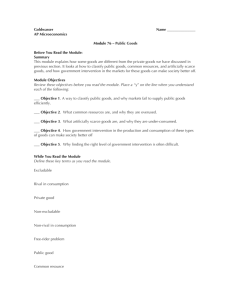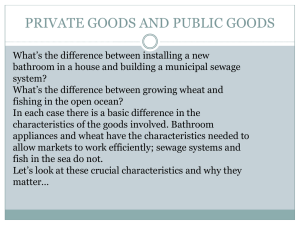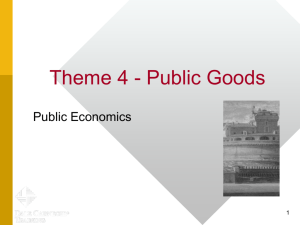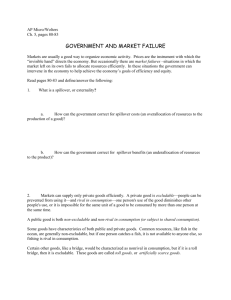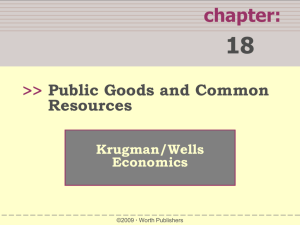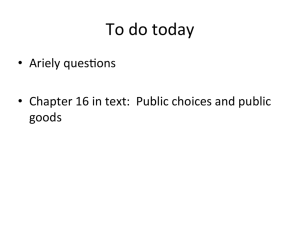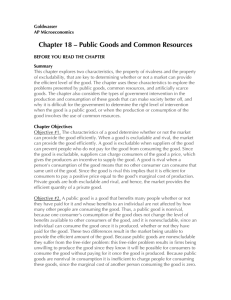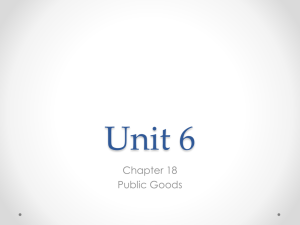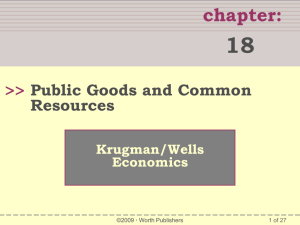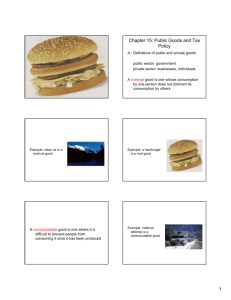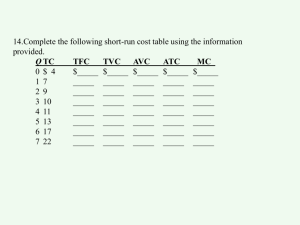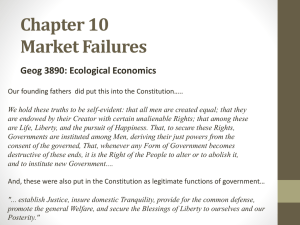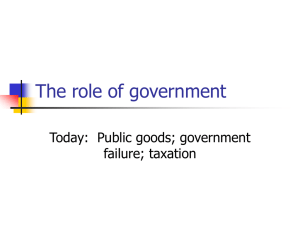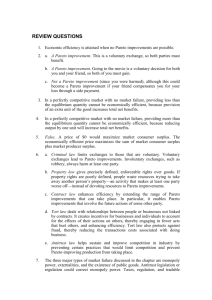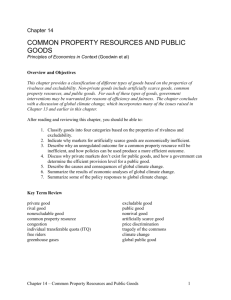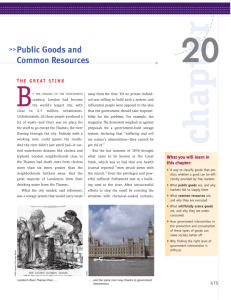Unit 8.2: Public Goods
advertisement
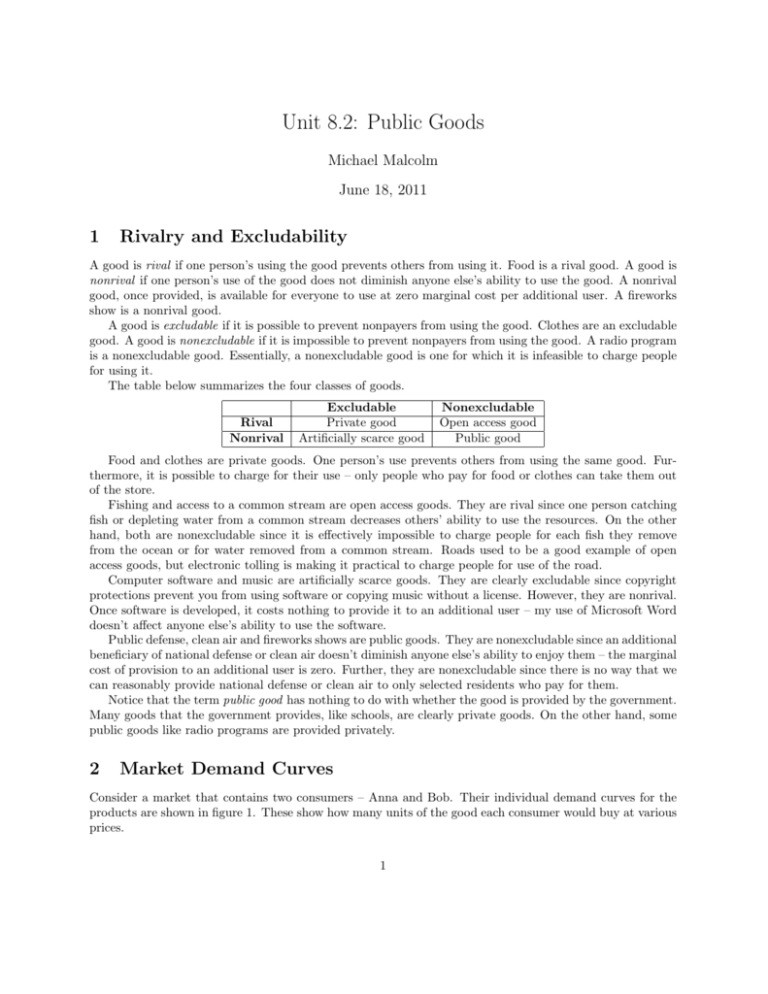
Unit 8.2: Public Goods Michael Malcolm June 18, 2011 1 Rivalry and Excludability A good is rival if one person’s using the good prevents others from using it. Food is a rival good. A good is nonrival if one person’s use of the good does not diminish anyone else’s ability to use the good. A nonrival good, once provided, is available for everyone to use at zero marginal cost per additional user. A fireworks show is a nonrival good. A good is excludable if it is possible to prevent nonpayers from using the good. Clothes are an excludable good. A good is nonexcludable if it is impossible to prevent nonpayers from using the good. A radio program is a nonexcludable good. Essentially, a nonexcludable good is one for which it is infeasible to charge people for using it. The table below summarizes the four classes of goods. Rival Nonrival Excludable Private good Artificially scarce good Nonexcludable Open access good Public good Food and clothes are private goods. One person’s use prevents others from using the same good. Furthermore, it is possible to charge for their use – only people who pay for food or clothes can take them out of the store. Fishing and access to a common stream are open access goods. They are rival since one person catching fish or depleting water from a common stream decreases others’ ability to use the resources. On the other hand, both are nonexcludable since it is effectively impossible to charge people for each fish they remove from the ocean or for water removed from a common stream. Roads used to be a good example of open access goods, but electronic tolling is making it practical to charge people for use of the road. Computer software and music are artificially scarce goods. They are clearly excludable since copyright protections prevent you from using software or copying music without a license. However, they are nonrival. Once software is developed, it costs nothing to provide it to an additional user – my use of Microsoft Word doesn’t affect anyone else’s ability to use the software. Public defense, clean air and fireworks shows are public goods. They are nonexcludable since an additional beneficiary of national defense or clean air doesn’t diminish anyone else’s ability to enjoy them – the marginal cost of provision to an additional user is zero. Further, they are nonexcludable since there is no way that we can reasonably provide national defense or clean air to only selected residents who pay for them. Notice that the term public good has nothing to do with whether the good is provided by the government. Many goods that the government provides, like schools, are clearly private goods. On the other hand, some public goods like radio programs are provided privately. 2 Market Demand Curves Consider a market that contains two consumers – Anna and Bob. Their individual demand curves for the products are shown in figure 1. These show how many units of the good each consumer would buy at various prices. 1 Figure 1: Individual demand curves We are interested in finding the market demand curve. Suppose first that the good is a private good. In this case, for each price, we add up the quantities that the consumers want to buy at that price. For example – At a price of $16, Bob wants 1 unit and Anna doesn’t want any, so the total market demand is 1 unit. However, at a price of $4, Anna demands 3 units and Bob demands 7 units – for total market demand of 10 units. The market demand curve for the case where the good is a private good is shown in figure 2. It sums the quantities that the consumers demand at each price. In other words, the demand curves are summed horizontally. Suppose instead that the good is a public good. In this case, once a particular unit is provided, it is available for all consumers to use. Therefore, we sum up the total willingness to pay. For the first unit that is provided, Anna is willing to pay $6 and Bob is willing to pay $16. Thus, the total willingness to pay for the first unit is $22. Again, the critical point here is that, once provided, the first unit is available for both to use, so we can add up their willingness to pay. The rest of the curve is derived similarly. For example, Anna is willing to pay $2 and Bob is willing to pay $8 for the fifth unit, so the total willingness to pay for the fifth unit is $10. For the eighth unit, Bob is willing to pay $2 and Anna is not willing to pay anything. The market demand curve for the case where the good is a public good is shown in figure 3. It sums the prices that the consumers are willing to pay for a given quantity. In other words, the demand curves are summed vertically. Quantitatively, suppose that a market is comprised of 50 individuals, each of whose demand curve for a product is 1 Qindividual = 5 − P 2 If the good is a private good, then we find the market demand by adding up each consumer’s quantity demanded for a given price: 2 Figure 2: Market demand for a private good Figure 3: Market demand for a public good 3 1 Qmarket = 50 5 − P = 250 − 25P 2 If the good is a public good, then we find the market demand by adding up the price that consumers are willing to pay for a given quantity of provision. Note that the individual demand curve can be rewritten as P = 10 − 2Qindividual . So then, the market demand curve for the public good is: P market = 50 (10 − 2Q) = 500 − 100Q 3 Efficient Provision of Public Goods Suppose in figure 3 that the marginal cost of providing each unit of the public good is M C = 10. The efficient level of provision is clearly Q = 5. The problem is that the private level of output will only be Q = 4 if each contribute privately. All four units are provided by Bob. Even privately, he gets enough benefit to justify providing the first four units for $10 each. The problem is that Anna and Bob together are willing to pay $10 for the fifth unit to be provided, but neither individually is willing to pay for the fifth unit. Intuitively, this is exactly the same problem with provision of national defense or any other public good. Society may collectively be willing to pay enough to justify providing national defense, after adding up everyone’s willingness to pay. But nobody individually gets enough benefit to justify paying for an army. To make this idea more general, consider a simple model with one private good and one public good in an economy with n consumers. The price of the private good is P = 1. The price of the public good is P = Pg . The efficient level of provision for the public good is the level of provision where: n X M RSi = Pg i=1 The M RS of each consumer i is the number of units of the private good he is willing to give up in exchange for one unit of the public good. If an apple costs $1 and a mile of street costs Pg , then providing the public good is efficient as long as the sum of the number of apples consumers are willing to give up exceeds the costP of providing the public good. In other words, the public good should continue to be provided as long as M RS > Pg , stopping when equality is reached. 4 Free Riding The efficient level of provision is unlikely to be reached privately. The problem is that each consumer has an incentive to under-contribute. Since the good is nonrival and nonexcludable, it is available to everyone at zero cost once provided. Each person would prefer to be a free rider than to contribute to the public good. To illustrate this problem, consider a simple game. Two neighbors are considering whether to hire a guard that will benefit both neighbors if hired. The cost of hiring the guard is $10. If hired, each neighbors receives a benefit of $8. Clearly it is efficient to hire the guard – collectively, the neighbors are willing to pay $16 for the guard, but it costs only $10 to hire him. However, let us frame this as a game. If both contribute, each gets the $8 benefit and pays $5. If only one contributes, then the contributor nets -$2 since he gets an $8 benefit from the guard but pays all $10 himself. The other neighbor free rides and enjoys an $8 benefit without contributing. Summarizing the game below, where C stands for ”contribute” and N stands for ”not contribute”. C N C 3,3 8,-2 4 N -2,8 0,0 The Nash Equilibrium of this game is (N,N). The public goods problem is ultimately just a prisoner’s dilemma. All society would be better off if each person contributes. But there is then an unavoidable incentive for each person to under-contribute and free ride – enjoying the benefits of everyone else’s contributions. In some sense, the analysis is similar to a positive externality. Each person’s contribution creates uncompensated benefits for outside parties, which ultimately results in under-provision since each individual does not fully realize the total benefits of his own contributions. 5 Resolving the Free-Rider Problem One solution is to create social pressure for individuals to contribute. Also, there may be warm-glow giving, meaning that people get some utility out of contributing. That is, listening to a public radio show that I contributed to gives me more happiness than free riding and listening to a public radio show that other listeners funded. Another obvious solution is government intervention. Provision of public goods is one of the strongest rationales for government intervention in the economy since it is clear that such goods will be underprovided in the private sector. Providing national defense is certainly worthwhile collectively – the value to society justifies the cost of providing it. However, it would be difficult for a private company to provide national defense up to the efficient level because of free-rider issues. Each individual in the country would prefer to enjoy the benefits but not contribute. As a simple example, suppose that providing a fireworks show would cost $5000 and that 1000 residents in town would each get $10 of benefit from watching the show. The show probably could not be funded privately because of free-rider issues. If, however, the government simply charges everyone a $5 tax and then provides the show itself, the problem is resolved. Everyone is better off as a result of the government intervention – after all, each resident pays only $5 to see a show that was worth $10 to him. This public good is efficient to provide, but it could not be provided in a private market. Government intervention is a Pareto improvement here. The problem with the government solution is the same as we discussed earlier with externalities. It is unlikely that the government has perfect information when making these decisions. Benefits from public goods might be difficult to quantify, making decisions about whether a project is efficient unclear. Furthermore, there are agency problems with government provision of anything. Government-run enterprizes do not have incentives to minimize costs like private firms. Furthermore, we teach that the core principle of economics is that people respond to incentives – so why should we assume that government officials are acting in the public interest rather than in their own best interest? 6 Common Resource Goods Common resource goods are different from public goods because they are rival. While one person benefitting from national defense does not prevent me from enjoying the benefits of national defense, a fisherman who catches lots of fish depletes the supply of fish available for me. Common resource goods are generally overused in the market equilibrium. This is known as the tragedy of the commons. Total fish production would be higher if each fisherman limited his catch and did not overfish. But if all fishermen limit their catch, then each individual fisherman has an incentive to overfish in order to raise his profit. Of course, once everyone cheats, the outcome is worse for everyone. This again reduces to a prisoner’s dilemma. Several solutions make themselves apparent. • A tax reflecting the harm caused to others – In the case of fish, each farmer could be charged a tax reflecting the social harm caused by overfishing. • Private property rights – If a single entity owns fishing rights, then he has an incentive to fish only to efficient levels and not excessively deplete resources. 5 • Quotas • Restricted access The last two solutions seem good in principle. Of course, if it is possible to restrict access, then the good is no longer a common resource good. 7 Artificially Scarce Goods Artificially scarce goods are goods that can be provided to additional users at zero marginal cost, which implies that the efficient price is P = 0. However, because the goods are excludable, the firm ”artificially” creates a scarcity of the product by charging a nonzero price for it. A good example is computer software or music. Once developed, a piece of software could be distributed to consumers over the Internet at zero marginal cost to the firm. However, the firm artificially induces scarcity by charging for a license and enforcing copyright laws. Pricing above marginal cost creates a deadweight loss. The problem is that, while a piece of software or music might be costless on the margin (i.e. providing it to another customer costs the firm nothing), giving it away for free would not allow the firm to recoup the fixed cost of developing it in the first place. The obvious solution is that the government can subsidize the fixed cost, after which the firm prices the good at marginal cost (giving it away for free in the case of software or music). This eliminates the deadweight loss from pricing above marginal cost and also compensates the firm for its fixed costs. This kind of argument applies to many goods that have a significant fixed cost but a low marginal cost. Examples are prescription drugs and textbooks, all of which are priced with substantial overcharges above marginal cost, leading to large deadweight losses. 6
